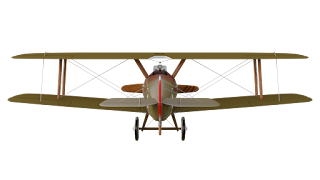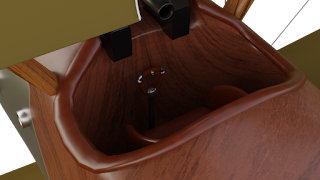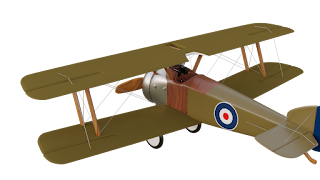Sopwith Camel (new project) and new updates for: Fokker Dr.I - May 12, 2025
Hello everyone. It's me Antony, back with another Blog in 2025.
I know. New year, new big surprises, new big changes and new updates related to my 3D projects.
Now that I'm working on the new role as health community agent, my colleagues and I are visiting the families as part of our job to improve the health quality in our community and town. Things are looking good and we're enjoying in our new role.
And, again, new Nightwave chapter is still on - with announcement of its conclusion for the next Nora Mix. As usual. (: /)
Let's go for what it's important than Warframe. For this Blog, I'm going to share you the latest images of a new project I started recently.
Yeah, I'll never get tired of starting new projects while I got plenty of others in development.
The aircraft of choice is the Sopwith Camel model F.1. - one of the famous British biplanes built by Sopwith Aviation Company during World War I. Let me tell its story:
The Sopwith Camel was developed from the Sopwith Pup as the Germans introduced the newest Albastros D.III - faster and better armed compared to the Pup. In response, Herbert Smith started designing a new version of the biplane, which would lead to the creation of the Sopwith Camel. The newer aircraft had a metal fairing over the gun breeches, intended to protect the guns from freezing at altitude, creating a "hump" that led pilots to call the aircraft “Camel”, although this name was never used officially. The prototype Camel flew for the first time on December 22 1916, by Harry Hawker (one of the future founders of Hawker Aviation) at Brooklands, Weybridge, Surrey. The Camel had a conventional design for its era, with a wire-braced wooden box-girder fuselage structure, an aluminium engine cowling, plywood panels around the cockpit, and a fabric-covered fuselage, wings and tail. While possessing some clear similarities with the Pup, it had a noticeably bulkier fuselage. Its armament consists of two 0.303 in (7.7 mm) Vickers machine guns mounted directly in front of the cockpit, synchronized to fire forwards through the propeller disc. In May 1917, the first production contract for an initial batch of 250 Camels was issued by the British War Office. Throughout 1917, a total of 1,325 Camels were produced, almost entirely the initial F.1 variant. Unlike the Pup and the Triplane, the Sopwith Camel has been described as difficult to fly, having light and sensitive controls - making it extreme maneuverability and its difficult handling to the close placement of the engine. In addition, the torque of its Clerget 9B rotary engine made the Camel difficult to turn left, which resulted in a nose-up attitude, but the torque also resulted in being able to turn to the right quicker than other fighters. Still, several aircraft crashes occurred when piloted by inexperienced pilots when the full fuel load pushed the aircraft's centre of gravity beyond the rearmost safe limit. The first operational debut occurred in June 1917 with No 4 Squadron being equipped with Sopwith Camel F.1 models, with victories racking up for the Allies. The biplane quickly proved to be superior to the Albatros D.III and D.V. Together with the S.E.5a and the SPAD S.XIII, it helped to re-establish Allied aerial superiority for a time. An important role for the Camel was home defense, when several planes from Eastchurch and Manston airfields were rallied against daylight raids by German zeppelins, including Gotha bombers, from July 1917. When the Germans switched to night operations, the Camel proved to be a capable aircraft at night operations. The biplane was also used as a naval fighter with the 2F.1 variant, as well in a series of trials as a parasite fighter, attached to the Airship R23 as a mothership. Despite facing obsolescence as a day fighter when confronted by the Fokker Dr.I and D.VII, the Sopwith Camel continued serving in the Royal Flying Corps as a ground attack aircraft by attacking German lines with Cooper bombs and low-level strafing runs. After World War I, the Sopwith Camel saw service during the Russian Civil War when the White Army confronted the Bolsheviks until retiring from service in January 1920 with 5,490 units built.
Here are the images of the Sopwith Camel.
Just like the Fokker Dr.I, the Sopwith Camel has been pretty easy to make, despite the aluminum "hump" to protect the Vickers MGs being the trickiest part to make. The rotary engine was imported from the German triplane in order to speed up its development.
Like the Fokker Dr.I, I'll try not to abuse the Subdivision Surface too much. Some components will not receive the modifier - like the wheels, the MGs and the engine.
The wings look nice, although I've been working on the tips for a while - trying some ideas to conclude it. And then I did it. Let me show you what I did.
The Sopwith Camel with its wings concluded and the tail elevator. In addition to the wings, I made the ailerons from the extracted pieces from the two wings and added the wires that links from one wooden pylon to another.
Minor adjustments were the temporary material for the fuselage and the upper section of the wings, the base for the undercarriage being stretched a little bit and shortening the fuselage's tail.
Alright. What I did was: I added more wires to the wings, a telescopic sight with a metal bead, the tail skid, the outlets for the engine and the Vickers MGs. The latest addition was the wooden propeller blade being imported from the Fokker Dr.I.
The British biplane received a windshield to protect its pilot and sights; a stick and more wires linked to the ailerons, elevator and tail. But the big change is the texture for the fuselage being made with Blender and Gimp. I included the Royal Flying Corps roundel according to its design and year of service.
The aluminum parts that connects with the wooden part has a small piece that looks odd. I may fix it later.
While I was working on its texture, I included the American Air Force roundel from World War I. And yes, the Americans received a surplus of Sopwith Camels when they joined the Triplice Entente - forming the Allies with Britain, France, Belgium, the Kingdom of Italy, the Russian Empire (before leaving the conflict due to the Bolshevik Revolution in 1917), the Empire of Japan, Romania, Portugal, Greece, Montenegro, Serbia and other nations; and of course - Brazil.
 |
| Sopwith Camel with Royal Flying Corps roundels |
 |
| Sopwith Camel with USA Air Force roundels |
Pretty cool, right? I also included the Belgium roundels, although some pictures never show the roundel on the fuselage. Still, it looks good.
The next images will show you the rigging for the biplane. And yes, I imported the Armature to attach the model to its Armature.
The elevator works nice. The wires linked to that component is following good. The vertices from the wire linked to the tail is bound to the Bone for the Aircraft.
Same thing I did for the ailerons. The Bones from the Lower Ailerons are using the Copy Rotation - following the Bones from the Upper Ailerons; and the Right ones is following the Left ones.
Funny thing is: I barely started Camel and now it's almost complete. Due to the simplicity and lack of details, I believe I can complete the Sopwith Camel in no time. The next thing to do is correcting the mask for the aluminum on the fuselage, painting the rudder and the wings. Probably I'll conclude it along the Fokker Dr.I.
About the Fokker Dr.I, I'm going to show you what I did.
The Fokker Dr.I received the textures for the Metal and Specular nodes. The Bump and Weathering images will be made once I conclude the next video. Probably it will be the last video of the series. Like I said before: due to the low number of details and simplicity, I believe I can conclude the aircraft and the series in no time.
In the meantime, I've been working on Werner Voss (Voß)'s Fokker triplane.
Looks good - even more with the original painting on the engine cowling.
Just to change a little bit, I'm going to share you the pictures of the young German pilot that commanded that triplane.
Looking at Werner Voss in some photos you can get an idea that he was quite young, although in the last one he looked a bit older (probably due to the wrinkles and shadows / dark circles around his eyes).
Well, that's it for now my friends. I hope you like this Blog. Let us hope this year bring us new content and something different from the usual. In case I have some spare time to enjoy, I'll be working on other things aside from Blender projects and my personal things. Until the time comes, you will be surprised to see them. See you next time.
My DeviantArt:
My second Youtube channel:
My other Blogspot places:
My Facebook page:
My Instagram:
My ArtStation:
My Pixiv:
My Sketchfab:
My Twitter / X:
My Bluesky:
Note: Don't you dare to download these images and re-share it without my permission. If you do, please, leave the original author name.
























































Comments
Post a Comment